Designed as a
supersonic superiority fighter, the F-104
was produced in two major versions. Armed
with a six-barrel M61 20mm Vulcan cannon, it
served as a tactical fighter, and equipped
additionally with heat-seeking Sidewinder
missiles, as a day-night interceptor.
Development of the F-104 began in 1952, and
the first XF-104 made its initial flight in
1954. On May 18, 1958, an F-104A set a world
speed record of 1,404.19 mph, and on Dec.
14, 1959, an F-104C set a world altitude
record of 103,395 feet. The Starfighter was
the first aircraft to hold simultaneous
official world records for speed, altitude
and time-to-climb.
The USAF procured
about 300 Starfighters in one and two-seat
versions. In addition, more than 1,700
F-104s were built in the United States and
abroad under the military aid program for
various nations including Canada, West
Germany, Italy, Norway, the Netherlands,
Belgium, Denmark, Greece, Turkey, Spain,
Taiwan and Japan.
|
|
SPECIFICATIONS:
|
PERFORMANCE: |
| Span:
21 ft. 11
in.
|
Maximum speed:
1,320 mph
|
|
Length:
54
ft. 10 in. |
Cruising speed:
575 mph
|
|
Height:
13
ft. 6 in. |
Range:
1,250 miles
|
|
Empty Weight:
|
Service ceiling:
58,000 ft. |
|
Gross Weight:
27,853 lbs. maximum
|
|
|
Crew:
Pilot |
|
Engines:
One General Electric J-79 of 15,800
lbs. thrust (with afterburner)
|
|
Armament:
One M-61 20mm cannon, two air-to-air missiles, nuclear or conventional bombs
|
| |
|
|
SOURCE:
National Museum of the United States
Air Force |
|
|


.jpg)
%20(8X4).jpg)